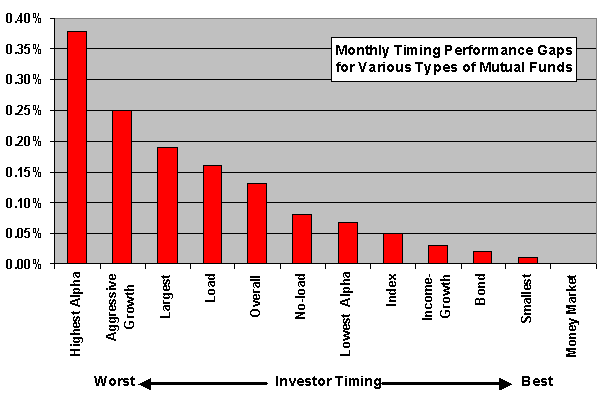Do mutual fund investors move their money into and out of the stock market at the right times, or the wrong times? In their August 2006 paper entitled “Mutual Fund Flows and Investor Returns: An Empirical Examination of Fund Investor Timing Ability”, Geoffrey Friesen and Travis Sapp examine the flows of funds to/from individual mutual funds to measure the timing ability of fund investors. They define a “performance gap” between the time-weighted (buy-and-hold) return and the dollar-weighted (actual investor average) return as the measure of investor timing ability. Using monthly data for 7,125 mutual funds over the period 1991-2004, they find that:
- For the entire sample, poor timing decisions reduce average investor returns by 1.56% annually. In general, withdrawal timing is worse than purchase timing.
- The timing performance gap generally increases with fund load, expenses, turnover and age, suggesting that larger, older, more costly funds attract unsophisticated investors.
- Investors in equity index funds also exhibit poor investment timing, but their timing is not as bad as that of investors in actively managed funds.
- Poor timing correlates positively with fund alpha (excess risk-adjusted return), to such an extent that the poor timing cancels the alpha even among the best-performing funds.
- Poor timing correlates positively with a momentum style of investing, but negatively with a value style.
- Poor timing correlates positively with fund return volatility, with the worst timing associated with aggressive growth funds (3% annual timing penalty).
- Results indicate that equity investors chase good past returns and flee bad past returns.
- Investor underperformance due to timing is small for bond funds and non-existent for money market funds, suggesting involvement of sophisticated investors.
The following chart, constructed from data in the paper, summarizes the monthly performance gaps (penalties) for average investors in various types of mutual funds. The larger the gap, the worse the market timing by fund investors. The figure suggests that investors who chase the returns of the most aggressive funds are the worst market timers, and investors seeking income are the best market timers. In no case does the average fund investor beat the market based on timing.

In summary, mutual fund investors would generally be better off with a buy-and-hold rather than buy-and-sell-and-buy-and-sell investing strategy.